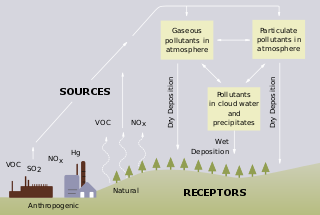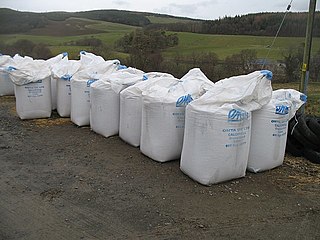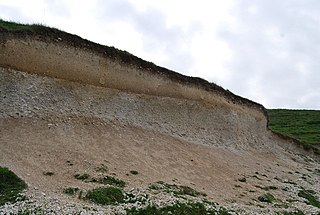Related Research Articles

Acid rain is rain or any other form of precipitation that is unusually acidic, meaning that it has elevated levels of hydrogen ions. Most water, including drinking water, has a neutral pH that exists between 6.5 and 8.5, but acid rain has a pH level lower than this and ranges from 4–5 on average. The more acidic the acid rain is, the lower its pH is. Acid rain can have harmful effects on plants, aquatic animals, and infrastructure. Acid rain is caused by emissions of sulfur dioxide and nitrogen oxide, which react with the water molecules in the atmosphere to produce acids.
Halotolerance is the adaptation of living organisms to conditions of high salinity. Halotolerant species tend to live in areas such as hypersaline lakes, coastal dunes, saline deserts, salt marshes, and inland salt seas and springs. Halophiles are organisms that live in highly saline environments, and require the salinity to survive, while halotolerant organisms can grow under saline conditions, but do not require elevated concentrations of salt for growth. Halophytes are salt-tolerant higher plants. Halotolerant microorganisms are of considerable biotechnological interest.
An organic acid is an organic compound with acidic properties. The most common organic acids are the carboxylic acids, whose acidity is associated with their carboxyl group –COOH. Sulfonic acids, containing the group –SO2OH, are relatively stronger acids. Alcohols, with –OH, can act as acids but they are usually very weak. The relative stability of the conjugate base of the acid determines its acidity. Other groups can also confer acidity, usually weakly: the thiol group –SH, the enol group, and the phenol group. In biological systems, organic compounds containing these groups are generally referred to as organic acids.

Soil pH is a measure of the acidity or basicity (alkalinity) of a soil. Soil pH is a key characteristic that can be used to make informative analysis both qualitative and quantitatively regarding soil characteristics. pH is defined as the negative logarithm (base 10) of the activity of hydronium ions in a solution. In soils, it is measured in a slurry of soil mixed with water, and normally falls between 3 and 10, with 7 being neutral. Acid soils have a pH below 7 and alkaline soils have a pH above 7. Ultra-acidic soils and very strongly alkaline soils are rare.

In chemistry, there are three definitions in common use of the word "base": Arrhenius bases, Brønsted bases, and Lewis bases. All definitions agree that bases are substances that react with acids, as originally proposed by G.-F. Rouelle in the mid-18th century.

Sodium carbonate is the inorganic compound with the formula Na2CO3 and its various hydrates. All forms are white, odourless, water-soluble salts that yield alkaline solutions in water. Historically, it was extracted from the ashes of plants grown in sodium-rich soils. Because the ashes of these sodium-rich plants were noticeably different from ashes of wood, sodium carbonate became known as "soda ash". It is produced in large quantities from sodium chloride and limestone by the Solvay process, as well as by carbonating sodium hydroxide which is made using the Chlor-alkali process.

Plant nutrition is the study of the chemical elements and compounds necessary for plant growth and reproduction, plant metabolism and their external supply. In its absence the plant is unable to complete a normal life cycle, or that the element is part of some essential plant constituent or metabolite. This is in accordance with Justus von Liebig’s law of the minimum. The total essential plant nutrients include seventeen different elements: carbon, oxygen and hydrogen which are absorbed from the air, whereas other nutrients including nitrogen are typically obtained from the soil.

In chemistry, neutralization or neutralisation is a chemical reaction in which acid and a base react with an equivalent quantity of each other. In a reaction in water, neutralization results in there being no excess of hydrogen or hydroxide ions present in the solution. The pH of the neutralized solution depends on the acid strength of the reactants.

Agricultural lime, also called aglime, agricultural limestone, garden lime or liming, is a soil additive made from pulverized limestone or chalk. The primary active component is calcium carbonate. Additional chemicals vary depending on the mineral source and may include calcium oxide. Unlike the types of lime called quicklime and slaked lime, powdered limestone does not require lime burning in a lime kiln; it only requires milling. All of these types of lime are sometimes used as soil conditioners, with a common theme of providing a base to correct acidity, but lime for farm fields today is often crushed limestone. Historically, liming of farm fields in centuries past was often done with burnt lime; the difference is at least partially explained by the fact that affordable mass-production-scale fine milling of stone and ore relies on technologies developed since the mid-19th century.

Liming is the application of calcium- (Ca) and magnesium (Mg)-rich materials in various forms, including marl, chalk, limestone, burnt lime or hydrated lime to soil. In acid soils, these materials react as a base and neutralize soil acidity. This often improves plant growth and increases the activity of soil bacteria, but oversupply may result in harm to plant life. Modern liming was preceded by marling, a process of spreading raw chalk and lime debris across soil, in an attempt to modify pH or aggregate size. Evidence of these practices dates to the 1200's and the earliest examples are taken from the modern British Isles.

Calcareous is an adjective meaning "mostly or partly composed of calcium carbonate", in other words, containing lime or being chalky. The term is used in a wide variety of scientific disciplines.
Hydrophobic soil is a soil whose particles repel water. The layer of hydrophobicity is commonly found at or a few centimeters below the surface, parallel to the soil profile. This layer can vary in thickness and abundance and is typically covered by a layer of ash or burned soil.
Soil acidification is the buildup of hydrogen cations, which reduces the soil pH. Chemically, this happens when a proton donor gets added to the soil. The donor can be an acid, such as nitric acid, sulfuric acid, or carbonic acid. It can also be a compound such as aluminium sulfate, which reacts in the soil to release protons. Acidification also occurs when base cations such as calcium, magnesium, potassium and sodium are leached from the soil.
Soil biodiversity refers to the relationship of soil to biodiversity and to aspects of the soil that can be managed in relative to biodiversity. Soil biodiversity relates to some catchment management considerations.
Upland rice is a type of rice grown on dry soil rather than flooded rice paddies. It is sometimes also called dry rice.

The outflow of acidic liquids and other pollutants from mines is often catalysed by acid-loving microorganisms; these are the acidophiles in acid mine drainage.
Biotic stress is stress that occurs as a result of damage done to an organism by other living organisms, such as bacteria, viruses, fungi, parasites, beneficial and harmful insects, weeds, and cultivated or native plants. It is different from abiotic stress, which is the negative impact of non-living factors on the organisms such as temperature, sunlight, wind, salinity, flooding and drought. The types of biotic stresses imposed on an organism depend the climate where it lives as well as the species' ability to resist particular stresses. Biotic stress remains a broadly defined term and those who study it face many challenges, such as the greater difficulty in controlling biotic stresses in an experimental context compared to abiotic stress.

Base-cation saturation ratio (BCSR) is a method of interpreting soil test results that is widely used in sustainable agriculture, supported by the National Sustainable Agriculture Information Service (ATTRA) and claimed to be successfully in use on over a million acres (4,000 km2) of farmland worldwide. The traditional method, as used by most university laboratories, is known variously as the 'sufficiency level', sufficiency level of available nutrients (SLAN), or Index(UK) system. The sufficiency level system is concerned only with keeping plant-available nutrient levels within a well studied range, making sure there is neither a deficiency nor an excess. In the BCSR system, soil cations are balanced according to varying ratios often stated as giving 'ideal' or 'balanced' soil. These ratios can be between individual cations, such as the calcium to magnesium ratio, or they may be expressed as a percentage saturation of the cation exchange capacity (CEC) of the soil. Most 'ideal soil' theories stress both approaches.

William Albert Albrecht chairman of the Department of Soils at the University of Missouri, was the foremost authority on the relation of soil fertility to human health and earned four degrees from the University of Illinois at Urbana–Champaign. As emeritus professor of soils at the University of Missouri, he saw a direct link between soil quality, food quality and human health. He drew direct connections between poor quality forage crops, and ill health in livestock and from this developed a formula for ideal ratios of cations in the soil, the Base Cation Saturation Ratio. While he did not discover cation exchange in the soil as is sometimes supposed, he may have been the first to associate it with colloidal clay particles. He served as 1939 President of the Soil Science Society of America.
Twenty years before the phrase 'environmental concern' crept into the national consciousness, he was lecturing from coast to coast on the broad topic of agricultural ecology.
" The soil is the ‘creative material’ of most of the basic needs of life. Creation starts with a handful of dust.” Dr. William A. Abrecht.

Freshwater acidification occurs when acidic inputs enter a body of fresh water through the weathering of rocks, invasion of acidifying gas, or by the reduction of acid anions, like sulfate and nitrate within a lake. Freshwater acidification is primarily caused by sulfur oxides (SOx) and nitrogen oxides (NOx) entering the water from atmospheric depositions and soil leaching. Carbonic acid and dissolved carbon dioxide can also enter freshwaters, in a similar manner associated with runoff, through carbon dioxide-rich soils. Runoff that contains these compounds may incorporate acidifying hydrogen ions and inorganic aluminum, which can be toxic to marine organisms. Acid rain is also a contributor to freshwater acidification. It is created when SOx and NOx react with water, oxygen, and other oxidants within the clouds.
References
- ↑ Robert Alan Lewis. (1998). Lewis' Dictionary of Toxicology. CRC Press. (p. 17).
- ↑ Acidophobe. (n.d.) -Ologies & -Isms. (2008). Retrieved March 15 2022 from https://www.thefreedictionary.com/Acidophobe
- ↑ "acid, -acidi-, acido-, -acidity". Robertson's Words for a Modern Age: A Dictionary of Latin and Greek Words used in Modern-English Vocabulary. wordinfo.info. Retrieved 2006-08-26.
- ↑ Iqbal, M. T. "Acid tolerance mechanisms in soil grown plants." Malaysian Journal of soil science 16.1 (2012): 1-21.
- ↑ Yost, R. S. "Plant tolerance of low soil pH, soil aluminum, and soil manganese." Plant Nutrient Management in Hawaii’s Soils 11 (2000): 113-115.
- ↑ Rao, I. M.; Zeigler, R. S.; Vera, R.; Sarkarung, S. (1993). "Selection and Breeding for Acid-Soil Tolerance in Crops". BioScience. 43 (7): 454–465. doi:10.2307/1311905. ISSN 0006-3568.
- ↑ Jiang, Tinghui; Zhan, Xinhua; Xu, Yangchun; Zhou, Lixiang; Zong, Lianggang (2005). "[Roles of calcium in stress-tolerance of plants and its ecological significance]". Ying Yong Sheng Tai Xue Bao = The Journal of Applied Ecology. 16 (5): 971–976. ISSN 1001-9332. PMID 16110682.